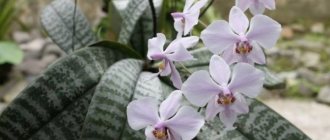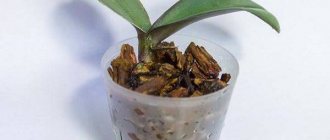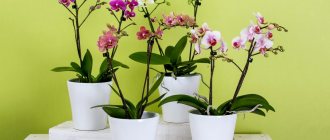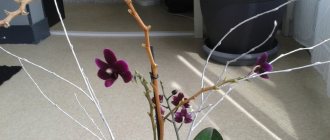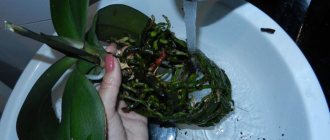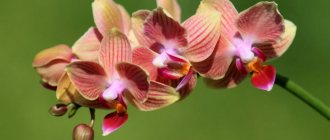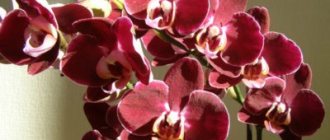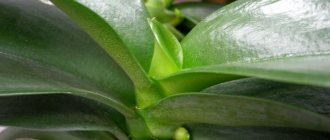Blue orchids are popular with many home plant lovers; the vast majority of stores offer phalaenopsis colored in various ways. Bright inflorescences on a thin stalk are in constant high demand in flower shops and cost twice as much as ordinary orchids. But in nature, phalaenopsis with this color does not exist, which not all flora lovers know about. Sellers rarely warn buyers about the necessary measures to preserve artificial colors, so most painted orchids quickly acquire a natural white color. What technologies exist for coloring phalaenopsis blue and is it possible to change the color at home?
The history of the blue orchid
Blue orchids were first presented in 2011, at an exhibition in Florida, by an agricultural company called Silver Vase. After 3 months, one of the participating firms demonstrated its version of the blue flower. After this event, all flower shops began to offer applications for the sale of blue or blue orchids. The Geest Orchideeën company, which was the second to show a blue flower, did not hide the fact that the color was obtained chemically and in subsequent blooms the orchids will be their natural color. The technique used by the representatives has not been disclosed to date, but experienced flower growers have found their own techniques.
Interesting! There is only one conclusion in this situation, the deep blue color of the orchid is not a feature of the variety, but only a desire to attract attention, which is achieved by coloring. In Western countries, such flowers are often used to decorate rooms for celebrations.
Is it possible to paint a plant this color at home?
There is nothing complicated about painting yourself. Use specialized paints from flower shops. Coloring can be done in two ways: by injection into the peduncle and into the root.
In the first case, the lower bud on the stem is selected, freed from scales, and a needle is inserted into it. The procedure must be performed carefully; if unsuccessful, the plant may die.
It is not advisable to color the roots, since in this case there is a risk of uneven coloring, the aerial roots turn blue, and the plant becomes untidy.
Varieties with a blue tint
Despite the fact that deep blue orchids have not yet appeared in nature, there are still species that slightly correspond to this color scheme:
- The Vanda orchid is a variety to highlight. In nature, it can be found in the forests of China or Thailand. Vanda's purple or lilac flowers are covered with white spots. The variety is not very suitable for growing at home because it needs special care. But Vanda has the ability to cross well with other varieties of orchids, which many breeders use for their own purposes. The result is species of orchids with varying intensities of purple color.
- Cattleya is another orchid that is not as demanding of care as Vanda. During flowering, this variety has a very delicate aroma, but also does not have a rich blue or light blue color. Sometimes in stores you can find purple or pink-blue Cattleya.
- Phalaenopsis is the most unpretentious variety of orchids that can most often be found at home. In addition, this particular variety is sold in blue in stores. Phalaenopsis takes root well in homes where there are people with allergies; this plant does not have cloying odors and does not emit pollen.
Attention! All of the above species do not have the blue color we are talking about and in the most ideal version they can only have a bluish tint.
Breakthrough of Japanese breeders: Phalaenopsis Aphrodite Royal Blue
The Japanese continue to amaze the world with their ingenuity. So, in 2013, an exhibition dedicated to orchids was held in Okinawa, where the world's first blue phalaenopsis . The flower is the result of the work of scientists, genetic engineers and breeders from Chiba University.
In fact, this is an ordinary white phalaenopsis of Aphrodite, to which a color gene from Commelina (blue-eyed) was introduced. The resulting phalaenopsis turned out to be very successful; it produces up to 30 small flowers, up to 5 centimeters in diameter. Unfortunately, due to its exclusivity, this plant is not yet available to a wide range of gardeners.
Phalaenopsis Aphrodite Royal Blue.
How can you tell if an orchid is colored?
Whether an orchid is painted or not is quite easy to understand if you pay attention to a number of signs:
- the stem of a normal orchid is of natural color, without the shades inherent in the flower;
- if a colored mark remains on the skin after touching a flower, it means that orchid paint has been applied to it;
- the soil in which the plant grows should also not show signs of coloring, its color is completely natural.
Important! If you are lucky enough to buy a blue orchid, you should know that the initial care for it is slightly different, because the plant was subject to chemical and mechanical intervention.
Tips for shopping in a store
Signs of artificial color
You can identify an artificially colored orchid by the following signs:
- The stem is of a color unusual for this flower, often with streaks.
- If you touch the blue parts of the plant, the skin may turn blue.
- The substrate in which the flower grows also takes on an uncharacteristic shade.
How to get blue orchid flowers?
There are two ways that help give blue tones to a white flower. The most humane of them is coloring through water that is watered on the plant. This method has the disadvantage that when watering stops, the flower returns to its natural color. In addition, the stem of the orchid also becomes somewhat blue during watering. To obtain the desired effect, it is enough to dissolve the dye in water in the required concentration; the more dye, the richer the color of the flowers.
Important! It should be remembered that the use of dyes is harmful to the plant.
A blue orchid at home can be obtained after coloring injections. The injection is usually given in the area of the peduncle; it should be carried out as least traumatically as possible. You need to take a syringe with the thinnest needle and fill it with liquid with dye.
For mixing, it is better to take warm, settled water, and the injection site and the needle itself must be disinfected. If there is no opportunity or desire to buy chemical coloring preparations that are available in flower shops, you can use food coloring.
Important! It is better to carry out coloring injections by piercing the peduncle; introducing the drug into the roots is the most traumatic for the orchid.
It is necessary to understand that any of the methods is potentially dangerous for the orchid and can lead to diseases and even death of the plant. After applying the coloring material, the flower needs additional care.
Consequences of color change
Any paint contains aggressive chemicals. Their introduction into the peduncle does not occur without consequences.
- Gas exchange disturbance. The capillaries become clogged and the plant cannot breathe fully.
- Diseases and pests. Natural immunity is lost, resistance to diseases and pests is lost. Sores and rot may appear at the injection site. When dye is introduced into the roots, they inevitably rot.
- Death of the plant. This is the most common outcome of the experiment. At best, it is partially restored, but still remains weakened.
Caring for a painted orchid after flowering will vary slightly. It is better to cut the peduncle immediately, without waiting for the re-formation of buds or children. It will take more time to recover. The flower needs to be provided with the most comfortable conditions.
Painting does not affect the genetic code of the plant in any way. This is a temporary change, of which there will be no trace left by the next flowering. If you want to diversify your collection with a blue orchid, look for Vanda or Cattleya in stores.
Further actions
If you bought a painted orchid at a flower shop, you should not rush to replant it. Depending on how long ago the procedure was carried out, the flower needs a period of rest and the opportunity to adapt to new conditions.
If you notice a deterioration in the condition of the orchid after purchase, you need to take some measures:
- Carefully remove the plant from the pot and rinse the roots under running water.
- Trying to find traces of injections, if they are found in the root area, it will be difficult to save the orchid.
- Usually the place where the injection was made forms rot; it is advisable to cut off this place and apply crushed coal or ash.
- After inspection, transplant the orchid into new soil, which consists of moss and bark.
- In the future, if the orchid begins to recover, care for it is standard, intended for the variety.
Reproduction methods
If you bought not a vanda or cattleya, but a painted orchid, follow the propagation method of phalaenopsis. It propagates mainly by pups and cuttings.
Cuttings
Cuttings are an effective and fairly simple method. Cuttings are taken only from a healthy plant that is not affected by pests and diseases. Take a side shoot. Cut it into several parts. On each, two nodes with axillary buds are left. The container is filled with wet sand or sphagnum moss. The cuttings are laid horizontally. The container is covered with film on top.
The soil in the greenhouse is regularly moistened, and the film is removed daily for ventilation. In about a month, full-fledged babies will form on the shoot segments. They are separated and planted in separate containers after the formation of their own root system.
Growing up from children
Children develop from dormant buds. Formed on the stem, peduncle. Children rarely develop on their own. Usually their development has to be stimulated. Several methods of stimulation are used.
- Dividing the main plant. The method is risky, suitable only for completely healthy plants. In the case of a painted orchid, it is better not to use it. The essence of the method is to cut off the top and root it. The lower part continues to be looked after until the children with roots appear.
- Reducing watering and temperature changes. Watering is stopped for 15 days, daily temperature changes of 7-9˚C are achieved.
- Hormonal stimulants. Flower shops sell a special hormonal paste. With its help, you can quickly awaken a sleeping kidney and stimulate the formation of a baby from it. The covering scale is removed from the upper bud of the peduncle. Work carefully, use a sharp blade and tweezers. Every four days, the dormant bud is treated with paste. The orchid is kept in a warm room at temperatures up to 30˚C. In the coolness, instead of babies, a bud is formed. Grown-up children are separated from the peduncle and planted.
You can take pieces of peduncles as cuttings. After flowering, it is cut off, divided into pieces of three to four centimeters and planted similarly to cuttings from a side shoot. One dormant bud is left on each segment.
Lighting
Lighting conditions are very important for any type of orchid. If the pot with the plant is placed on the west side, you can practically eliminate the need for artificial lighting.
The western side of the window prevents direct sunlight from entering the flower.
It is also possible to place an orchid on the south side of the apartment all year round, but on hot days it is necessary to control the soil moisture and add water if necessary. The location of the orchid pot on the windowsill on the north side requires the installation of additional phyto lamps, which will extend the daylight hours.
The orchid blooms best if it is illuminated for 12-16 hours.
Interesting! If there are no purple pigment spots on the inside of the leaf, this indicates that the orchid does not have enough lighting.
Despite its light-loving nature, the sun can be dangerous for orchids during its active period; at this time it is better to hide the plant in the shade. If it is not possible to extend the daylight hours for an orchid, cut it off for the winter and leave it until the lighting increases naturally.
Coloring by watering
This technology is the most gentle color changing method. In this case, the color will be noticeable on all parts of the plant. To get the result, a special floral paint is diluted in water, which is subsequently used to water the phalaenopsis.
The effect lasts only during the period of watering with colored water; as you switch to regular, settled water, the color disappears.
How gossip affects the development of society: quotes about gossip, rumors and news
Who lived the best under the USSR? What did Soviet residents envy when they arrived in Georgia?
How to give money in an unusual and festive way: 5 ideas that are easy to repeat
Technology: the dye is diluted in a container with water, the concentration is determined experimentally, then the pot with the plant is immersed in the container for 15-20 minutes. With this method of changing color, the flower does not suffer, the absence of mechanical damage guarantees its integrity. Experts consider the only drawback of the method to be weak coloring and rapid discoloration of the pigment.
Watering and fertilizing
The watering regime should be adjusted independently, based on the ambient temperature; the faster the moisture evaporates from the pot, the more often it is necessary to add water. In any situation, the humidity level must not be exceeded, as this can cause rotting of the root system.
For many gardeners, the immersion method is convenient, in which the pot along with the plant is lowered into a container filled with water for 30-60 minutes. After the pot is cured, excess moisture is drained through the drainage holes.
If you use watering in the form of bathing the orchid, you need to do this under a weak water set or use a shower. Then let the water drain and remove moisture from the axils of the leaves.
Due to the unusually bright colors, it becomes clear why the blue orchid is so popular. Before you decide to carry out the coloring procedure at home, you should understand that interfering with the natural course of an orchid’s life can be detrimental to its health.
Maintenance and care
After dyeing, it is very important to maintain the correct conditions for keeping the flowers, this will extend their life. Let's take a closer look at each of the mandatory points.
Optimal conditions of detention
These plants love heat very much, so it is important that the temperature ranges from 18 to 30C . If this rule is not followed, the blue orchid is susceptible to various pests and is susceptible to many diseases.
Important! During the dormant period, the temperature should be slightly lower than during active growth of the orchid.
You also need to remember about the correctly selected light mode. In spring and summer, it is recommended to keep the plant on the balcony so that it can receive a sufficient amount of sunny color. In this case, it is necessary to avoid sunburn on the leaves or flowers of the orchid. In the winter-autumn period, special lamps are used to increase the level of illumination.
All phalaenopsis need good lighting.
How to water to preserve blue pigment?
The amount of watering depends on the time of year - in summer it is necessary to moisten the flower more often than in winter. On average, it is recommended to water once every 3-4 days in summer, and once every 7-10 days in winter.
In order to understand whether an orchid needs to be watered, it is enough to touch the soil: if it is very dry, then the plant requires moisture. For irrigation, it is better to use high-quality water at room temperature.
Root and foliar feeding
Fertilizing is carried out in the same way as for other varieties of orchids: during the period of vegetative growth. During the dormant phase, the plant needs rest, so it is not recommended to add fertilizers. For complementary feeding, it is best to use ready-made mineral mixtures, which are sold in specialized stores.
Seasonal features
After coloring your orchid, it is important to remember that the blue pigment does not last forever. After the dye is used up, the orchid produces regular white buds.
You should not do frequent painting, as this will lead to the death of the plant.
It is very important to monitor the condition of the flower, since after the introduction of pigment it is more susceptible to disease and damage by harmful microorganisms.
Advice! If the plant begins to die, then it is necessary to carry out urgent manipulations to resuscitate it: cut off the colored peduncle, completely change the substrate in the pot, check the condition of the root system (cut off rotten or dried areas). This way you can restore the health of the orchid.
And phalaenopsis is white!
Just like in the fairy tale about the naked king.
These flowers really look magical, you just can’t take your eyes off them!
But for everyone who bought phalaenopsis with blue flowers, the next flowering after the store one brought flowers either white with bluish streaks (where the paint had not yet come off), or pure white.
For those less familiar with orchids, this was a big disappointment as they initially thought it was a natural blue color.
Yes, unfortunately, all the blue phalaenopsis sold in stores and even at most exhibitions are some standard varieties with white but colored flowers...
Some stores do not even hide this and write on the sign under the price tag that this is not a natural color and the orchid blooms with blue flowers only once. At least this is fair to customers.
However, not everyone is so honest. There are many sellers who pass off painted phalaenopsis as a supposedly very rare natural species and charge exorbitant prices for it. And they call it Phalaenopsis Royal Blue, which can be translated as Royal Blue Phalaenopsis.
Phalaenopsis mini and Phalaenopsis miniature - what is the difference?
But in the DNA of natural phalaenopsis there is simply no gene that produces a blue pigment. Therefore, if you are convinced that this is a species orchid, this is pure deception.
Although Phalaenopsis Royal Blue does exist, it is not a natural species, or even a hybrid. You will not find such a name in the list of officially registered hybrids. Find out what it is below...
Growing conditions
Place and light
It is better to grow an orchid with blue petals not in the brightest light. The fact is that under the influence of intense rays of the sun, delicate petals can fade or even get burned. Therefore, the plant is shaded from the scorching sun, but nevertheless grown in conditions of abundant lighting, and not shade.
Air temperature and humidity
A blue orchid will feel good at an air temperature of +25-30 degrees. The plant needs high air humidity: in order to ensure such tropical conditions, it is necessary to regularly spray the orchid in the heat and winter.
Varietal diversity
And yet, in natural conditions, there are orchids that cannot be called blue, but shades of blue are present in them. First of all, this is Wanda, who grows up in Thailand.
Vanda is also called the Queen for the beauty and majesty of her flowers. It easily crosses with other species, which is actively used by breeders. It has the following colors:
- blue flowers with white bloom;
- blue with lilac dots;
- with yellow lips in the middle.
INTERESTING! This species does not go into dormancy and can bloom periodically throughout the year. It is able to grow without any substrate, since the powerful bark system allows it to obtain nutrition and moisture from the air. Of course, such an orchid needs to be watered occasionally.
Another representative of orchids with lilac-bluish flowers is Cattleya. The species closest to the blue color is Margaret Degenhardt “Saturn”, which breeders call space.
Blue Orchid Diseases
The introduction of a dye is already stressful for the orchid; the plant becomes weakened and more susceptible to disease, so at the first sign of disease you should immediately begin treating the flower.
Let's look at the main diseases of phalaenopsis and how to treat them:
- Bacterial spotting. Appears on the leaves: they turn yellow, may darken, spots or ulcers appear on them. It is treated by treating with fungicides, as well as removing diseased leaves.
- Powdery mildew. Symptoms: white coating, drying of the affected areas. Treatment method: treatment with Skor or Topsin-M.
- Sooty fungus. Appears as a black coating. Treatment: treatment with Mikosan, Ridomir, and Topsin-M.
- Rot. Symptoms: root and leaf softening, rot. As a treatment, it is recommended to trim the rotten areas, transplant the flower into another container with replacement of the soil, and treat with fungicides.
The blue orchid will become one of the most beautiful decorations in your collection of home flowers. With proper care, it is capable of giving joy to you and your household for a long time with its unusual appearance.
Is the dyeing process harmful to the plant?
Dyeing an orchid, although it seems like a fairly simple procedure, is actually a labor-intensive process that requires precise skill. If this is not done correctly, the coloring of the orchid can harm the plant. However, if everything is done professionally, the process will not harm the plant. During coloring, the orchid may become more susceptible to environmental conditions such as temperature, light and drafts.
Care Tips:
- When blue orchids are not blooming, there is no need to water as often as when they are in bloom. Once a week should be enough.
- The fertilizer mixture should be applied only once a month and no more.
Varieties
For many years, flower traders have been deceiving customers by selling them blue and blue orchids. Imagine the surprise of the new owner of the flower when, after flowering, it took on its natural color. And these are not the most negative consequences, since some specimens did not withstand chemical intervention at all and died. Currently, breeders have managed to develop several species whose color is close to blue. Hybrids belong to the orchid families such as Vanda, Cattleya, and Phalaenopsis.

